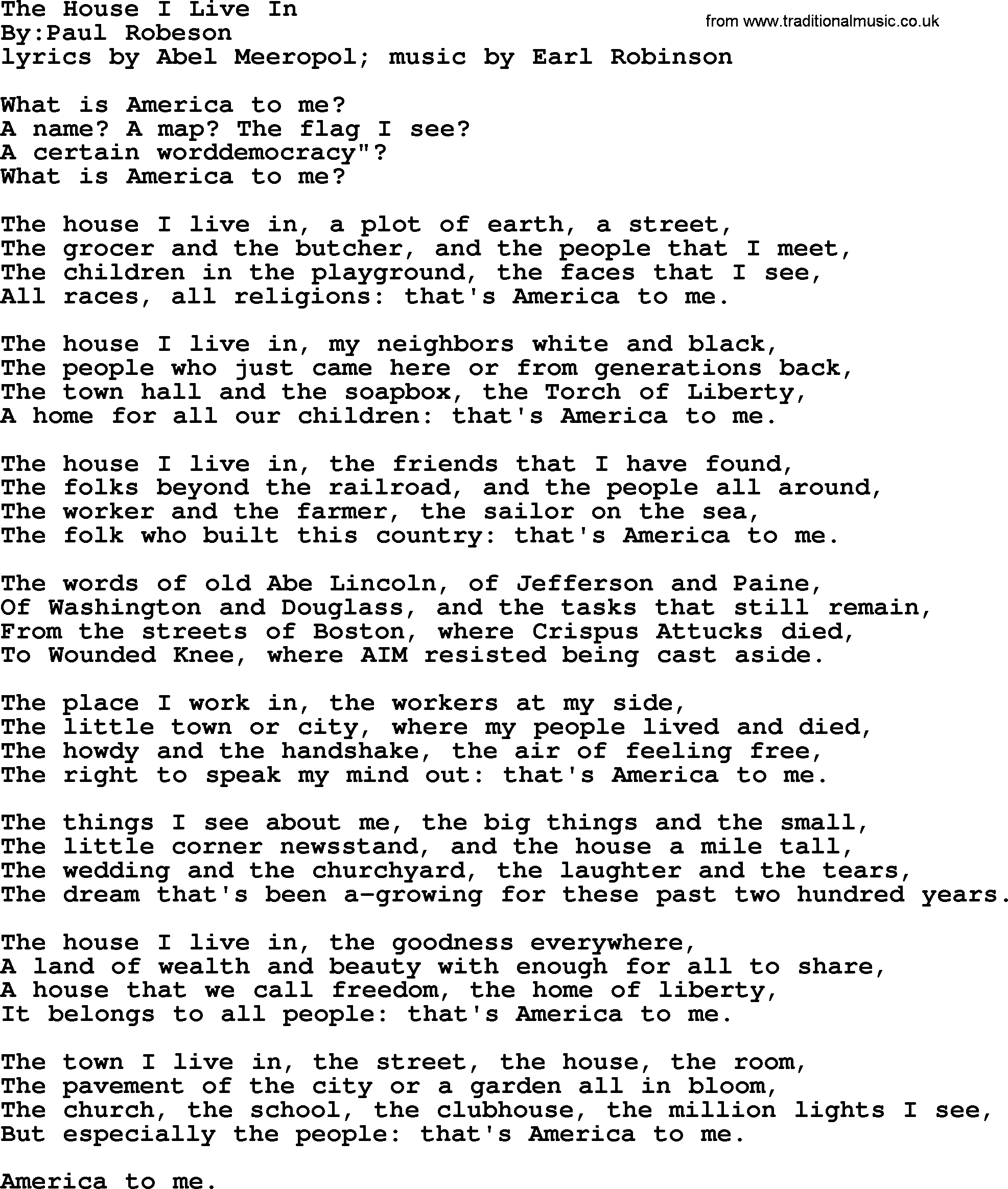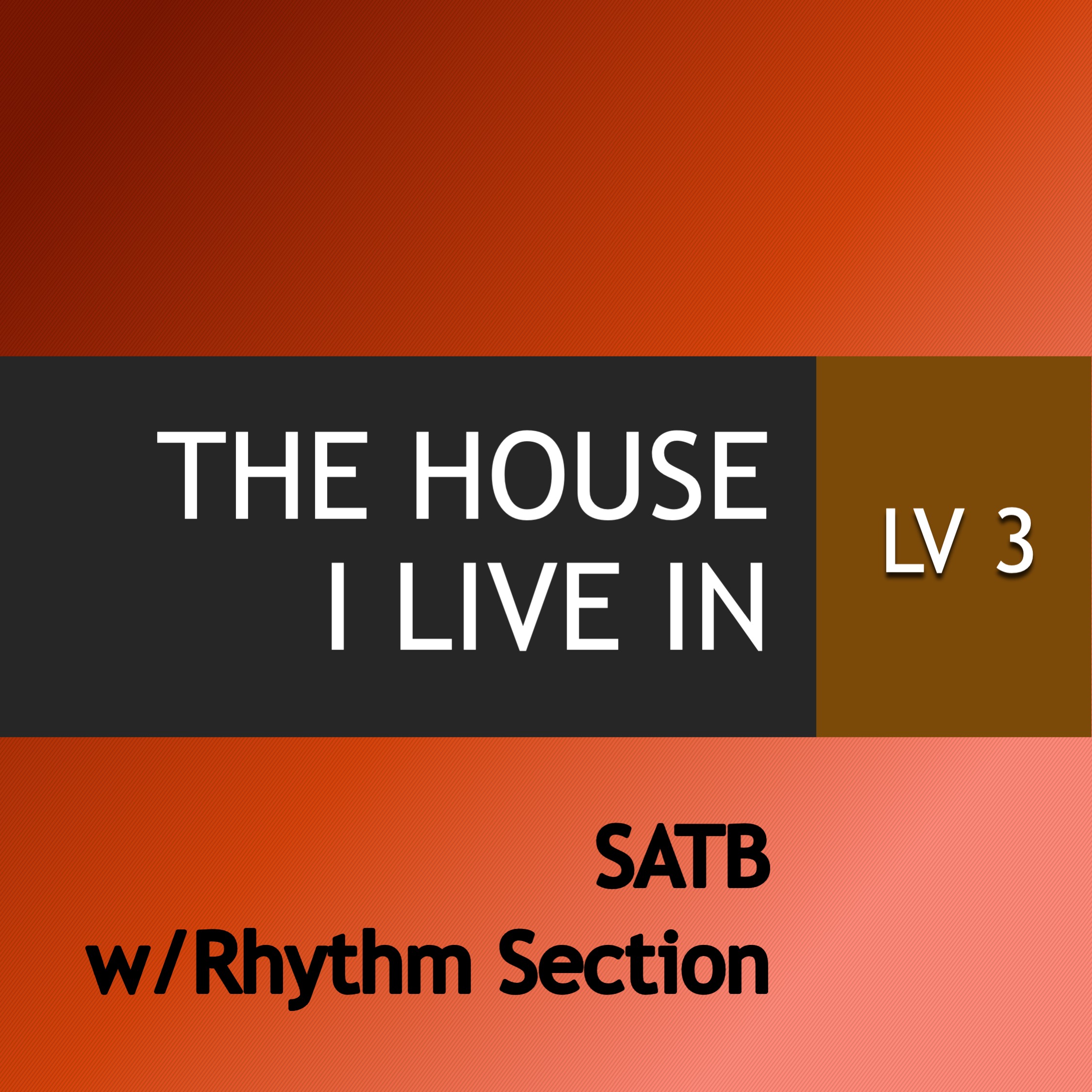"The House I Live In" Lyrics & Meaning: Discover Now!
Does a song, a simple melody and a few carefully chosen words, possess the power to encapsulate the very essence of a nation? "The House I Live In," a song that emerged during a pivotal moment in American history, attempts precisely that: to define America not through abstract concepts, but through the tangible realities of everyday life.
The genesis of "The House I Live In" coincides with a period of profound transformation for the United States. As the nation grappled with the Second World War and its aftermath, a surge of patriotic fervor swept the country. It was a time when the shared experience of sacrifice and unity fostered a deep yearning to define what it truly meant to be American. In 1942, songwriters Abel Meeropol, writing under the pseudonym Lewis Allan, and Earl Robinson, sought to channel this sentiment into a song that celebrated inclusivity and the ideals of democracy. Their composition became a powerful anthem, a testament to the values of community and belonging.
To provide a deeper understanding, here is a breakdown of the key players involved in the creation and performance of "The House I Live In":
- Obliterated Nude Scenes Sex Scenes See Them Now
- Decoding Macy Jones Story Social Justice Interests Discover Now
| Information | Details |
|---|---|
| Song Title | "The House I Live In" |
| Original Composer (Lyrics) | Abel Meeropol (pen name: Lewis Allan) |
| Original Composer (Music) | Earl Robinson |
| Year of Composition (Lyrics) | 1942 |
| Year of Composition (Music) | 1945 |
| Most Famous Performer | Frank Sinatra |
| Genre | Patriotic, American Standards |
| Notable Lyrics | "What is America to me? A name, a map, or a flag I see? A certain word: Democracy. What is America to me? The house I live in..." |
| Key Themes | Patriotism, Community, Democracy, Inclusivity |
| Impact | Became a widely recognized symbol of American ideals. |
For additional information, you can refer to Wikipedia.
The lyrics of "The House I Live In" are simple yet profound. The song begins with a question, "What is America to me?" The answers offered are not of grand pronouncements or historical narratives. Instead, the song anchors its definition of America in the concrete details of everyday existence: "the house I live in, a plot of earth, a street, the grocer and the butcher and the people that I meet." The song then expands this vision, portraying the diverse fabric of American society: "the children in the playground, the faces that I see, all races and religions, that's America to me."
The song was initially penned by Abel Meeropol (as Lewis Allan) and Earl Robinson, the creative minds behind the composition. Meeropol, known for his haunting ballad "Strange Fruit," which addressed the horrors of lynching, brought a keen understanding of social injustice to the project. Robinson, a composer with a history of political activism, added a musicality that would amplify the song's message of unity. It was a partnership born from a shared desire to use art as a tool for social commentary and the shaping of a more inclusive society.
Frank Sinatra's interpretation of "The House I Live In," recorded on January 2, 1964, in Los Angeles, is arguably the most iconic. Sinatra, at the peak of his career, brought his signature vocal style and emotional depth to the song, transforming it into a standard of American music. His rendition became synonymous with the song's message and resonated with audiences across generations.
However, the journey of "The House I Live In" was not without its complexities. The original intent of the song, advocating for racial harmony and national unity, sometimes encountered resistance. The line "My neighbors, white and black," written into the lyrics, was even omitted in certain renditions. This omission, as documented by Pascal from Boulder, CO, highlights the ongoing struggle for racial equality in America, even within the context of a song that championed the ideals of inclusivity.
The lyrics of "The House I Live In" have undergone various iterations, reflecting the changing interpretations and cultural context of the song. While the core message has remained consistent, minor variations in wording and phrasing have occurred across different recordings and performances. These nuances underscore the evolving nature of art and its adaptation to the values of the time.
Consider the imagery of the town: "the town I live in, the street, the house, the room, the pavement of the city, or a garden all in bloom." These descriptions, so commonplace, become the foundation for a grand statement about national identity. The inclusion of "the church, the school, the clubhouse" shows the diverse and inclusive vision of America.
The song's message of inclusion can also be seen in its depiction of the people. "The farmer and the worker, the sailor on the sea, the men who built this country, that's America to me." It recognizes the contribution of every individual and highlights that the true spirit of America is in its people.
Moreover, the song is not merely about dwelling on material possessions or personal spaces. It moves beyond the confines of property to embrace a wider context, reflecting on the values and experiences that bind a society together: "the howdy and the handshake, the air of feeling free." "The House I Live In" transcends the boundaries of a mere dwelling; it becomes a symbol of hope and belonging.
Furthermore, the song's success lies in its capacity to speak universally. By focusing on the fundamental elements of human experience -- home, community, shared dreams -- the song bypasses narrow ideological concerns. In doing so, it resonates with a broad audience, making the core values of the American dream accessible to all.
The songs ongoing relevance testifies to its timeless quality. Decades after its creation, "The House I Live In" continues to find new audiences. Its message of unity and democracy remains a powerful reminder of the ideals that have shaped the nation and the ongoing effort to achieve those ideals. The song provides a space for reflection and hope, urging listeners to embrace the beauty of diversity and the strength of collective identity.
The very act of singing, or hearing "The House I Live In," has the power to stir emotions and spark a sense of belonging. The music, which has been reimagined many times, still evokes patriotism, the common thread in the fabric of American life. This song is a reminder to be thoughtful about what it means to be part of a nation.
The impact of the song goes beyond its musical merit. It has become a symbol of American identity. "The House I Live In" serves as a reminder that the strength of a nation lies not just in its borders but in the shared values and experiences of its people. The song's lyrics, even when slightly altered, provide a blueprint for a just and inclusive society.
Moreover, "The House I Live In" is a reminder that the concept of "America" is not a static entity. It's constantly changing, evolving, and being redefined by the individuals who call it home. The song calls for an ongoing effort to realize the ideals of democracy, with a special emphasis on the importance of a society that welcomes everyone.
In the context of contemporary society, "The House I Live In" is especially pertinent. The lyrics remind us to remember how significant shared values are in a divided world. The song continues to serve as a unifying force and a call for reflection, especially as we navigate the challenges of an ever-changing world. The simple message of human connection and togetherness makes it a cultural touchstone.
The song's inclusion of the phrase "the house I live in" is not just a declaration of physical space. It is a metaphorical representation of America itself, built upon a sense of purpose and shared experiences. In the aftermath of a global conflict, this message of unity was very influential.
The music and the lyrics have had a lasting influence, encouraging all to think about what America means. It transcends generational and cultural boundaries and continues to inspire. Its lasting appeal reflects the ongoing search for common ground and belonging.
In conclusion, "The House I Live In" is more than just a song. It is a lyrical embodiment of the American dream, a tribute to the values of community, and a constant reminder of the ongoing quest for a more inclusive and democratic society. The song encourages introspection, prompting us to reflect on the true meaning of belonging and the ideals that bind a nation together.



Detail Author:
- Name : Loraine Aufderhar
- Username : voreilly
- Email : vlind@willms.info
- Birthdate : 1992-04-12
- Address : 5175 Vernon Junction Apt. 134 Lake Harold, TX 48339
- Phone : 972-903-9282
- Company : Reichel-Lind
- Job : Advertising Sales Agent
- Bio : Cum sed iure assumenda nihil. Ut recusandae dolore a animi facere. Eveniet quisquam quo omnis fugit porro consequatur. Quo blanditiis perferendis nam sed rerum velit aliquid.
Socials
facebook:
- url : https://facebook.com/bridgetpfannerstill
- username : bridgetpfannerstill
- bio : Consectetur perferendis blanditiis minus suscipit.
- followers : 2993
- following : 1593
instagram:
- url : https://instagram.com/pfannerstillb
- username : pfannerstillb
- bio : Voluptas ea ipsum nobis. Laboriosam quod ut ipsum quasi. Voluptas et quod quis impedit.
- followers : 2696
- following : 2809
tiktok:
- url : https://tiktok.com/@bridgetpfannerstill
- username : bridgetpfannerstill
- bio : Illo nisi in possimus modi ut quia.
- followers : 1572
- following : 2378